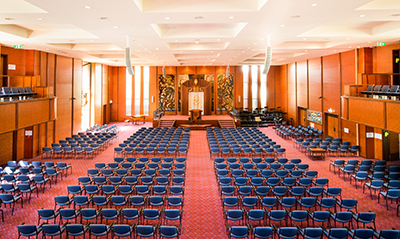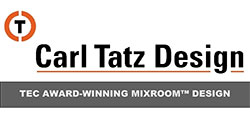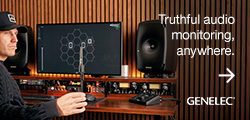![]() With an increasingly technology-savvy congregation, Melbourne’s Temple Beth Israel is the first synagogue in Australia to stream Shabbat services online. But that same awareness meant that the failing sound system needed to be replaced.
With an increasingly technology-savvy congregation, Melbourne’s Temple Beth Israel is the first synagogue in Australia to stream Shabbat services online. But that same awareness meant that the failing sound system needed to be replaced.
Poor directional control and speech intelligibility, and the inflexibility of the infrastructure limited the development of new services and events. The time was right to improve the usability of the Synagogue’s sanctuary spaces.
Rabbi Gersh Lazarow’s vision for a modern, flexible worship space in combination with the strong musical aspirations of Cantor Michel Laloum led to the appointment of Hanson Associates as the consulting engineer for both acoustics and audiovisual systems.

The consultants duly developed a performance specification for the new sound reinforcement system, identifying the products that would meet its challenging requirements. This resulted in integrators, Urban Intelligence, fitting a Martin Audio OmniLine micro line array to provide the versatility required. The system comprises four 12-element actively processed line arrays, supplied by Technical Audio Group, Martin Audio’s Australian distributor.
The challenge had been to enhance the worship experience throughout the main synagogue and adjacent Slome Hall – two ‘grand’ spaces, with significant spatial volume, separated by an operable wall. In combined format these spaces host large services, state funerals and music performances, when it can then accommodate up to 1,100 people. However, the space is generally subdivided, with worship occurring in the main synagogue and community events hosted in Slome Hall.
‘We nominated OmniLine because computer modelling, conducted by the engineering team using Martin Audio Display software and Ease, proved it could meet the stringent electroacoustic performance requirements,’ Hanson Associates’ Mark Hanson says. ‘The synagogue was also impressed with OmniLine’s small footprint and minimal visual impact.’
Hanson Associates’ prior experience of OmniLine in similar acoustically challenging environments proved invaluable to the project: ‘We knew the extended linear frequency response and superior pattern control of the OmniLines across a large listening area, and their ability to minimise acoustic energy ‘spill’ onto reflective surfaces, would guarantee a high level of system stability for a wide range of room formats,’ Hanson confirms.
Via Martin Audio’s Display 2 software, the company was able to model several scenarios and develop the final coverage pattern (and angles) for each line array configuration. ‘Where many traditional line array systems rely on passive arraying of line array elements, and the overall splay angles of the configuration to achieve a best possible coverage pattern, the optimised filters generated by the Display software enable an actively driven array to achieve drastic improvements in coverage and consistency across target listening areas,’ he says.
Hanson also cites the importance of specifically generated linear phase FIR filters for each of the 48-line elements in the four line array configurations to achieve a highly consistent seat coverage across all frequencies, while achieving impressive rejection of sound onto the stage and towards the upper balcony rear wall.
Beam steering
 Another advantage was the variable beam steering presets that were implemented for the Slome Hall line arrays – both with and without the operable wall retracted.
Another advantage was the variable beam steering presets that were implemented for the Slome Hall line arrays – both with and without the operable wall retracted.
During large services and events, the operable wall is retracted and the two pairs of OmniLine arrays are used in a main FOH and delay configuration. However, for most of the year, this wall is extended to separate Slome Hall from the sanctuary.
‘Via the Display software, a second set of FIR filters was exported into an audio DSP preset to generate an entirely different pattern from the same physical array which cuts off sharply at the operable wall at the rear of the room,’ Hanson says.
Each OmniLine hang is supported by custom bracketry, designed in conjunction with Urban Intelligence, to maximise the final tilt angles and allow cables to be concealed.
‘The results are stunning. Despite the live acoustic in Slome Hall, clarity of speech was instantly restored and the system was able to readily support day-to-day events at the tap of a touchscreen.’
‘With the control afforded by OmniLine, we have been able to achieve musical clarity and speech intelligibility – despite the reverberance,’ says Hanson. ‘We have also avoided the need to implement under-balcony fills, and all sightline requirements have been met.
‘The stability of the electroacoustic system, the success of the microphone and DSP mixer sections, and intuitive tablet user interface for the clergy has meant that complex services and events can be conducted involving multiple speakers and musicians without technical staff and sound engineers, as has been the case previously.’
The consultant credits other key personnel in the project including Mark Thompson of Hanson Associates who led the modelling work and undertook commissioning with David Gilfillan of Gilfillan Soundwork; Martin Audio’s Ambrose Thompson, for ongoing Display support as Hanson pushed the software and system to its limit; Urban Intelligence director, Lior Rauchberger, and site foreman Toby Leader.
More: http://tag.com.au
More: www.martin-audio.com












